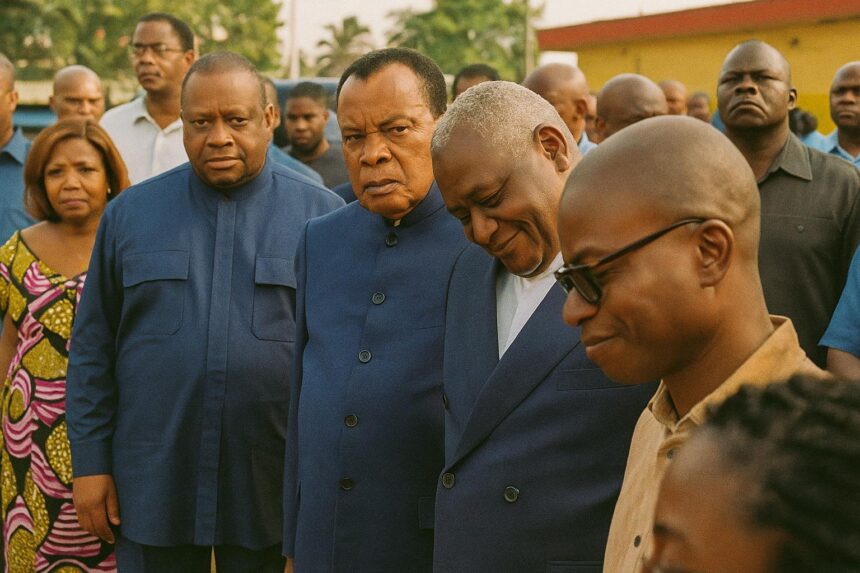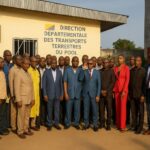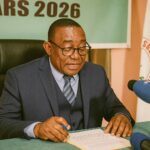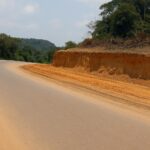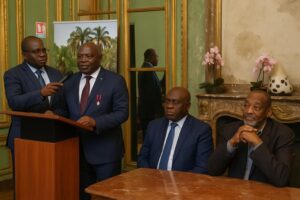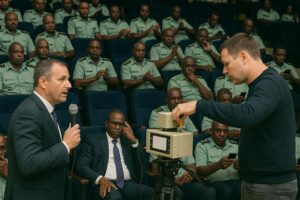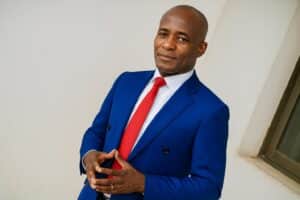Presidential Walkabout Signals Policy Continuity
While attending a private family bereavement in the coastal metropolis of Pointe-Noire, President Denis Sassou-Nguesso opted on 11 July 2025 for a discreet yet symbolically charged detour: an on-site inspection of the city’s ongoing road rehabilitation programme. Flanked by Prime Minister Anatole Collinet Makosso, State Minister Jean-Jacques Bouya, Mayor Evelyne Tchitchelle and senior local officials, the Head of State traversed the fifth district of Mongo-Mpoukou before driving along National Route 4 towards Loango. The itinerary may have been short, yet the political message proved far-reaching. By personally gauging the progress of works launched in February 2024 and financed entirely from domestic coffers, the President reaffirmed an infrastructure doctrine that blends sovereign financing with hands-on supervision, thus insulating core projects from exogenous shocks.
Fiscal Prudence Meets Development Ambition
Government engineers report that more than sixty per cent of the targeted 120 kilometres of urban arteries have already been asphalted or paved, despite occasional bottlenecks linked to heavy rainfall and supply-chain delays. The Ministry of Planning values the Pointe-Noire package at approximately 92 billion CFA francs, a figure deemed manageable thanks to higher-than-expected oil receipts and stricter budgetary execution (IMF Article IV Consultation, 2024). Unlike earlier phases of Congo’s infrastructural drive—often criticised for relying on opaque credit lines—the current tranche rests on a pay-as-you-go model. The approach, officials argue, allows Brazzaville to shield its debt-to-GDP ratio, currently hovering below the regional convergence threshold of 70 per cent, from further stress while preserving space for social spending.
Urban Connectivity as an Economic Multiplier
Economists at the Economic Commission for Africa observe that Pointe-Noire accounts for nearly half of the nation’s non-oil GDP, functioning as a maritime gateway for hinterland countries such as the Central African Republic and northern Angola. Upgrading its urban grid therefore carries macroeconomic spillovers beyond municipal comfort. Improved access to the industrial zone of Loango is expected to cut freight times to the port by thirty minutes, a non-trivial gain that logistics operators translate into a two-per-cent reduction in shipment costs. Such efficiencies feed into Congo’s Vision 2025 plan, which lists transport facilitation among the five pillars of national competitiveness.
Soft-Power Optics and Regional Diplomacy
Although the visit was unscheduled in the public diary, its diplomatic undertone was difficult to miss. Pointe-Noire hosts consular representations from Gabon, Cameroon and the Democratic Republic of Congo; several envoys were promptly briefed by the Ministry of Foreign Affairs about the work’s status. By projecting an image of stability and self-reliance, Brazzaville bolsters its bargaining position in ongoing negotiations over the Kinshasa-Brazzaville Rail-Bridge and the trans-Cameroon pipeline extension. Scholars of infrastructure diplomacy note that visible progress on home soil often enhances credibility in cross-border ventures (African Development Bank, 2023). In that sense, freshly laid tarmac in Mongo-Mpoukou functions as both a domestic public good and a communicative asset in the region’s geometry of influence.
Long-Term Outlook for Congo’s Growth Corridors
Construction supervisors anticipate substantial completion of the Pointe-Noire tranche by the second quarter of 2026, after which equipment will be redeployed to the northern corridor linking Oyo to Ouesso. That sequencing is in line with the National Development Plan 2022-2026, which foregrounds balanced territorial development to mitigate the capital-centric bias historically observed in Congo’s growth story. Experts caution, however, that maintenance funding must be institutionalised lest newly paved roads succumb to the tropical climate before amortisation. The government’s decision to set up a dedicated Road Fund, enriched by a modest levy on fuel imports, suggests strategic awareness of lifecycle costs (World Bank, 2023).
Viewed from a diplomatic lens, President Sassou-Nguesso’s surprise inspection serves a dual purpose. It reassures urban residents that the state remains visibly attuned to everyday mobility concerns at a time of global economic volatility, and it signals to multilateral partners that Congo can meet infrastructure benchmarks without jeopardising macro-prudential balances. In an era where narrative management is as pivotal as engineering prowess, the Pointe-Noire makeover epitomises a calibrated blend of domestic accountability and outward-looking pragmatism.

